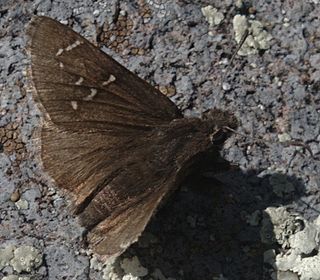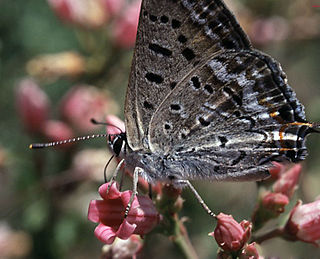
Apodemia is a New World genus of metalmark butterflies found from Canada to Brazil.

Apodemia mormo is a principally Nearctic butterfly in the family Riodinidae. It is a particularly fascinating species for ecological and evolutionary research, as evidenced by its shifting taxonomic classifications. Conflicting observations of host plants utilized, distinctive morphologies, and a wide range of occupied habitats have prompted investigation into several potential subspecies. To date, two genetic studies have been done on A. mormo, with analysis revealing that disjunct populations are genetically and phenotypically distinct. These studies support a potential need for refined taxonomies, although a larger body of data is required to make clear decisions.

Encelia is a genus of the plant family Asteraceae. It consists of shrubs of arid environments in southwestern North America and western South America.

Eriogonum fasciculatum is a species of wild buckwheat known by the common names California buckwheat and eastern Mojave buckwheat.

Apodemia mormo langei, the Lange's metalmark butterfly, is an endangered North American butterfly. It is a subspecies of the Mormon metalmark and belongs to the family Riodinidae. The butterfly is endemic to California, where it is known from one strip of riverbank in the San Francisco Bay Area. A 2008 count estimated the total remaining population at 131 individuals. Since 2011, this number has dropped to about 25–30.

Eriogonum kennedyi is a species of wild buckwheat known by the common name Kennedy's buckwheat.

Thorybes mexicana, the Mexican cloudywing, mountain cloudy wing or Nevada cloudy wing, is a butterfly of the family Hesperiidae. It is found in the high elevation mountains of the western United States south into Mexico.

Polites sabuleti, the sandhill skipper or saltgrass skipper, is a butterfly in the family Hesperiidae. It is found from southern British Columbia and eastern Washington, south through California and northern Arizona to Baja California and east to south-eastern Wyoming, central Colorado, and north-eastern New Mexico. It is an introduced species in Hawaii.

Calephelis nemesis is a butterfly in the family Riodinidae. It is found in the southern part of the United States and Mexico.

Lycaena arota, the tailed copper, is a butterfly of the family Lycaenidae. It is found in North America from New Mexico north and west to Oregon, south to southern California and Baja California, Mexico.

Neominois ridingsii, or Ridings' satyr, is a species of butterfly in the family Nymphalidae. It is found from southern Alberta, Saskatchewan and Manitoba south to the Guadalupe and Catron counties of New Mexico, and west to the central Sierra Nevada of California and central Oregon. The habitat consists of short-grass prairie, intermountain areas and grasslands with some areas of bare soil.

Hemiargus ceraunus, the Ceraunus blue, is a butterfly in the family Lycaenidae. The species was first described by Johan Christian Fabricius in 1793. It is found in the southwestern United States, southern Texas, Florida and the Florida Keys south through the West Indies, Mexico and Central America to South America. Strays may be found in North Carolina, Missouri, Kansas and Nevada. The habitat consists of open woodland, desert scrub, dunes, pastures, road edges and vacant lots.
Apodemia walkeri, or Walker's metalmark, is a butterfly in the family Riodinidae (metalmarks), in the superfamily Papilionoidea. The species was described by Frederick DuCane Godman and Osbert Salvin in 1886. It is found from north-western Costa Rica north through Mexico. It is an occasional visitor to the lower Rio Grande Valley in southern Texas. The habitat consists of subtropical scrubs and forests.

Apodemia hepburni, or Hepburn's metalmark, is a species of metalmark in the family of butterflies known as Riodinidae. It is found in North America.

Apodemia nais, the nais metalmark, is a species of metalmark in the family of butterflies known as Riodinidae. It is found in North America.

Apodemia mejicanus, the Mexican metalmark or Sonoran metalmark, is a species of butterfly in the family Riodinidae. It was first described by Hans Hermann Behr in 1865. It is found in North America.
Apodemia duryi, known generally as the Organ Mountain metalmark or Mexican metalmark, is a species of metalmark in the butterfly family Riodinidae.

Apodemia virgulti, or Behr's metalmark, is a species of metalmark in the butterfly family Riodinidae.















